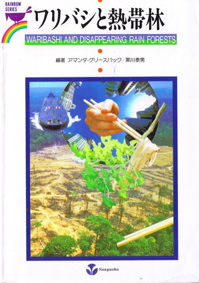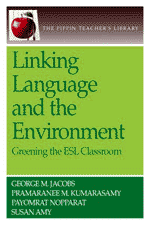Greening ESL
(English as a Second Language)
Greening English as a Second Language happens when we integrate environmental and sustainability issues, ideas and activities into English as a Second Language lessons. Whether you're working with adult students overseas, teaching youngsters who are new to your English-speaking country, or something in between,
greening English as a Second Language is easy.

Greening ESL is an approach that "will readily appeal to second language learners concerned with finding a more relevant, interesting and socially significant focus for their efforts at second language acquisition than they may be used to encountering.... Environmental education can prove a rich source of material for purposeful language learning."
— George M. Jacobs, Pramaranee M. Kumarasamy, Payomrat Nopparat and Susan Amy, in Linking Language and the Environment: Greening the ESL Classroom

Because there might not be a set curriculum for ESL, these classes offer a perfect opportunity to teach environmental and sustainability awareness. The communicative approach — the idea that successful language learning comes through having to communicate real meaning (rather than conjugating verbs or learning lists of vocabulary) — opens the door to students acquiring English language skills through learning about and sharing their knowledge of environmental and sustainability issues. Amanda Griesbach's exploration of the role of wooden chopsticks in rainforest destruction (right) is one example. Simply include
a "green" objective and an ESL objective
in every lesson or unit.
If you're teaching a language other than English as a second or additional language, then the same principles will hold true for you (see, for example, Environmental Education in French). If you teach English as a first language, please visit Green Language Arts and English.
ESL teachers will have to remember that more and more ESL students are going be climate change refugees, seeking new lives and new livelihoods in regions that could be experiencing climate change in their own ways.
ESL teachers can contribute to transformative sustainability education by helping their students
- learn about where they are living (nature connecting for younger students; bioregional learning for older students)
- compare environmental/sustainability issues where they are living now to where they used to live — or to where you (their teacher) come from:
- deforestation
- global warming and climate change
- air or water pollution
- garbage
- overconsumption of natural resources
- human rights and social equity
- animal rights
- food and water security
- green the ESL classroom (for example, use only double-sided printing, give online assignments, take walking field trips, fill the room with plants)
- watch nature movies in English (think David Attenborough), or listen to presentations by English-speaking environmental experts
- play nature games and go on hikes and scavenger hunts outdoors
- learn the nuances of English terms and cultural concepts such as
- needs versus wants
- facts versus beliefs versus opinions
- rights versus responsibilities
- head versus heart
- biophilia
- non-human animals
- write nature poems and songs in English, and create environmentally related art, movies, blogs/websites or drama
- write persuasive letters on environmental issues they care about
- learn to grow food "in English" (gardening together is a great way to get to know each other)
- explore
- sounds in the environment
- green gifts
- carbon footprint and energy audits
- community mapping
(with thanks to Linking Language and the Environment; see below)

For teaching English as a Second Language, an outdoor classroom has great potential for fun and learning.... You will be surprised how students become incredibly excited about their learning!... The context for the lesson is automatically set by being on the trail. The communicative opportunities are numerous and students will find it natural to attempt to communicate what they see, feel and hear. Take time to enjoy the magic of seeing a lizard basking in the sun or a butterfly fluttering around your head.
— Thom Henley and Kenny Peavy, in As If the Earth Matters: Recommitting to Environmental Education
Resources for Greening ESL

- Pippin Publishing offers Linking Language and the Environment: Greening the ESL Classroom by George M. Jacobs, Pramaranee M. Kumarasamy, Payomrat Nopparat and Susan Amy (ISBN: 0-88751-092-2).
- Peter Snashall's ESL Flow, in the UK, offers a repository of ESL lesson plans for teaching environmental issues and problems. (Note: The ESL Flow website has been irksomely monetized.)
- Roy Schwab and Brad Stocker at Miami Dade Community College present A Green Curriculum for Advanced ESL Students, including units on biophilia, cosmology and bioregional awareness. Their colleagues have posted several lesson plans on the Earth Ethics Institute's Lesson Plans or Course Modules with an Earth Literacy and Sustainability Perspective webpage. (On both sites, some of the links didn't work for me, but the ideas are there!)
- ESL Etc. Global Issues and Activism in English Language Teaching, an archived website by David Royal, provides ideas for greening ESL on the Greening an English Program page. (Some of David's pages are no longer available, but many are.)
Could there be any learning more relevant than learning about one's place in the world, whether home country or new home? Learning a new language allows a learner to expand their sense of place — to see it through new eyes — and to gain a new appreciation for it.
Return from Greening ESL to Integration
as an Ecological Teaching Tool
Visit Green Language Arts and English
Visit Environmental Education in French
Go to GreenHeart Education Homepage